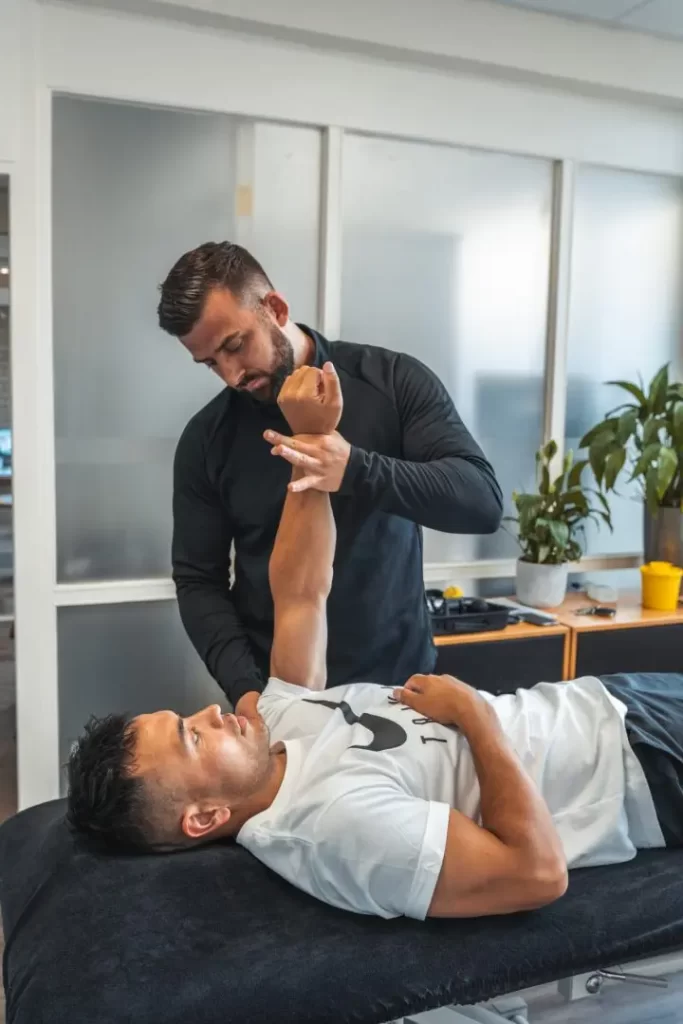Rotator cuff rupture
A rotator cuff rupture is a tear in one of the tendons of the rotator cuff, a group of four muscles and their tendons that surround and stabilise the shoulder joint. The rotator cuff plays a crucial role in moving and lifting the arm.
Causes of rotator cuff rupture
A rotator cuff rupture can occur due to:
- Acute injury: such as a fall, heavy lifting, or sudden movement.
- Chronic wear and tear: due to overuse, ageing or degeneration (often in people over 40).
- Repeated movements: for example, in athletes (swimmers, tennis players) or professions with a lot of overhand movements.
Risk factors for contracting a rotator cuff rupture
- Age over 40
- Degenerative changes
- Repeated overhand movements
- Occupations with heavy shoulder loads
- Poor circulation in the tendons
- Bone protrusions (spurs)
- Diabetes
- Smoking
- Overweight
- Familial predisposition
Complaints and symptoms
Diagnosis and examination
The diagnosis for a rotator cuff rupture is made on the basis of an interview combined with typical symptoms and physical examination. The physiotherapist performs a number of specific tests to determine whether a rupture has occurred and which muscle is affected. In addition to these tests, ultrasound can help in making a diagnosis. Our bodies are subject to wear and tear as we age. It is normal from a certain age to sometimes see tears in tendon tissue. Therefore, we have to remain cautious in what stamp we put on some symptoms.
Treatments and prognosis
A torn tendon will not heal on its own but is also not always operated on right away. Which treatment method is chosen depends on several factors. Often, good steps in recovery can already be made with physiotherapy. The aim of physiotherapy will be to improve the strength of surrounding muscles and reduce pain using mobilisations and exercise therapy. Sometimes this is done in combination with pain medication (NSAIDs). Should surgery be chosen, the torn tendon will be repositioned (as close as possible) to its original location. Then, in the first phase, the physiotherapist will provide an increase in mobility; slowly, work will also be done to restore strength.
PASTA lesion
PASTA stands for Partial Articular Supraspinatus Tendon Avulsion. When there is a PASTA lesion, the tendon of the supraspinatus is not completely torn but only the lower layer has become detached from the bone. This injury occurs almost exclusively at a younger age as a result of a major accident. This variant is less easy to examine and can often only be confirmed by means of a MRI.
Conclusion
A tear in one of the rotator cuff is more common in people who play a sport where the risk of injury is higher. Think falls or large peak loads. But there can also be a natural process. From the age of 60, we see that the quality of tendon tissue decreases, which can lead to injuries more quickly. Ultrasound can help in making a correct diagnosis especially when there is a big fall or when large forces come on the tendon through peak loads. Rehabilitation will always consist of gradually increasing mobility and slowly training strength again.
Making an appointment at FysioFitaal
We work from multiple locations in Tilburg, always close by for professional and accessible physiotherapy. Fill in the contact form and we will contact you soon. Together, we will work on your recovery!

